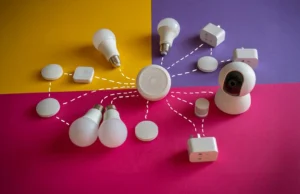What is IoT?
Internet of Things or briefly abbreviated as IoT is a network of devices connected with each other and further interacting with and sharing information amongst each other. So, a connected car, smart refrigerator, wearable fitness tracker, or even any other everyday thing falls into this category.The more internet-connected devices get, the smarter, efficient, and capable they prove to be in terms of automation.
Starting from health, where new efficiencies will come into place, through to manufacturing, where greater productivity and quality of life will be the result, IoT has revolutionized several industries. Companies and regulatory bodies need to know which of the following is not a market driver for the internet of things (IoT). Knowing the non-drivers will allow stakeholders to base some of their decisions on this knowledge of what investments and which strategies they should enforce.
Major Market Drivers of IoT
As we discuss ITs growth, a few prominent market drivers are at play. Noting these drivers is important in explaining which of the following is not a market driver for the internet of things (IoT):
Increased Connectivity
One of the major sectors that fuel IoT is the advance in internet connectivity. They can give a faster, better response with 5G technology as it allows devices to communicate faster and more reliably. Such connection enables real-time analysis of data processed, thus furthering this market’s growth. Clarified here is that which of the following is not a market driver for the internet of things (IoT).
Reduction in Cost in Technology
The cost of sensors, devices, and data storage has plummeted. When technology becomes much cheaper, companies embrace IoT solutions, and it is easier to entice growth in the market. It makes one understand which of the following is not a market driver for the internet of things (IoT).
Demand for Automation
Continuous process improvements and efficiency gains have companies seeking constant improvements in their business processes. Among such determinants, automation is one of the most significant factors, where labor costs go down, and productivity increases. However, if industries continue adopting automation, the demand for these IoT technologies would increase, resulting in illustrating what is a market driver and what is not.
Data Analytics
Among the other vital growth enablers for IoT is the ability to capture and analyze enormous amounts of data. Information gathered from data captured through IoT devices can enable businesses to make better choices and provide better services, hence going back to question 5, which of the following is not a market driver for the Internet of Things (IoT).
Consumer Expectations
Consumers are demanding more intelligent products today. With the increased comfort of people living with technology, they demand smart devices that will give them some advantage in terms of convenience and efficiency. This is an apparent driver in the market where the given drivers propel it, compared with the rest.
The factors that drive the growth in the IoT market combine to propel the growth but must differentiate the ones that do not contribute to such growth.

Misconceptions about IoT drivers
The discussion above which of the following is not a market driver for the Internet of Things (IoT) brings to light some of the most serious misconceptions. Let’s clear some of these up.
IoT only for big companies
A large number of people believe that only large organizations can work with IoT. In reality, medium enterprises can also use IoT technologies to improve processes and reduce costs. This misconception might veil understanding of which of the following is not a market driver for the Internet of Things (IoT).
IoT is Only a Trend
While many think of IoT as just a fad, the truth is that it represents something large and deep in the landscape of how we relate to technology shifts in how we interact with our environment. Misperception of this trend can lead to confusion about which of the following is not a market driver for the Internet of Things (IoT).
High Initial Costs
Even though up-front investments may pose some concerns, the long-term savings and benefits usually outweigh those concerns. Indeed, many businesses realize that IoT leads to significant cost reductions in the long term that complicates the discussion of which of the following is not a market driver for the Internet of Things (IoT).

Identifying Which Is Not an IoT Market Driver
To understand which of the following is not a market driver for the Internet of Things (IoT), one needs to establish those elements that do not contribute towards its development. Among those elements that are not acts of market drivers include the following:
Privacy Concerns
As the privacy issues are critical, it does not drive the market. On the other hand, it creates a roadblock. Consumers will unwillingly adopt IoT devices if they feel that data is being misused. Therefore, it is a non-driver when asking which of the following is not a market driver for the Internet of Things (IoT).
Integration Complexity
Such perceived complexity in integrating IoT systems may deter businesses from adopting IoT solutions. This complex does not breed market growth; rather, it might even deter it. Thus, the statement that is not a market driver of the Internet of Things (IoT) is:
Regulatory Issues
Regulation has its double-edged sword. There are some regulations related to safety and security, but over-regulation would choke innovation and delay further spread of IoT. This is yet another example of which of the following is not a market driver for the Internet of Things (IoT).
Lack of Standardization
The absence of a single standard for IoT may lead to confusion. However, a lack of standardization by itself is more of a restraint than a booster for growth, again underlining which of the following is not a market driver for the Internet of Things (IoT).
Lack of Awareness
Most consumers and businesses remain unaware of the benefits of IoT.This ignorance is a limitation to the market rather than being a driver, definitely fitting the non-driver’s criteria in the context of which of the following is not a market driver for the Internet of Things (IoT).
With the factors above identified as not being drivers, organizations can focus on those factors that can enable them to survive in the IoT landscape. This clarity is applied in answering the question of which of the following is not a market driver for the Internet of Things (IoT).

How Non-Drivers Influence the Evolution of IoT
Also, knowing what among the above is not a market driver for the Internet of Things (IoT) will help in understanding how non-drivers can influence the general landscape of IoT development.
The Adoption Rate is much more moderate
Non-users may imply a slower adoption rate. If companies have fears about privacy or are ignorant of it, they may demur from investing in IoT technologies. This scenario explains why it is important to determine which of the following is not a market driver for the Internet of Things (IoT).
Misallocated Resources
Wasting the resources on non-drivers. One can waste time and money trying to address issues that do not contribute to the growth of the market instead of using it for the actual drivers, which complicates the landscape of which of the following is not a market driver for the Internet of Things (IoT).
Innovation Stifling
Regulatory complexity can stifle innovations. Companies may feel companies are burdened by such rules or that technology is complex. Companies are less likely to develop new IoT solutions and are, therefore, shy away from realizing the recommendations of which of the following is not a market driver for the Internet of Things (IoT).
Low Consumer Involvement
If consumers are concerned about privacy or lack understanding of IoT, then the engagement will be limited. This can further slow the development of IoT applications that are user-friendly and effective, which is still proof again of which of the following is not a market driver for the Internet of Things (IoT).
Fragmented Market
Without standardization, the IoT market may fragment. Fragmentation does not make development easy and might confuse consumers, making it hard to grow even further. Recognizing fragmentation is critical in arriving at which of the following is not a market driver for the Internet of Things (IoT).
By knowing who non-drivers are, organizations will be able to plan more wisely and focus on actual growth potential- a direct answer to which of the following is not a market driver for the Internet of Things (IoT).
Conclusion
In a nutshell, anyone connected with this dynamic field needs to know which of the following is not a market driver for the Internet of Things (IoT). It is essential that not only the main drivers will move the IoT market, but also there should be a clearer definition of non-drivers, which might act as growth hindrances. By addressing true drivers such as increased connectivity, reduced cost, and the expectations of consumers, businesses will be better equipped to navigate through the IoT landscape and make informed decisions based on the exact understanding of which of the following is not a market driver for the Internet of Things (IoT).
FAQs
What is IoT?
Internet of Things is the network of devices that, once equipped with the ability to interconnect and exchange information over the internet, makes everyday objects intelligent.
What are the market drivers for IoT?
Key drivers are increased connectivity, cost reduction, demand for automation, data analytics, and consumer expectations.
What are some of the most common myths surrounding IoT?
Some of the common myths are that IoT is appropriate only for big companies. In fact, some people even believe it is just a fad.
Why is it important to understand non-drivers?
Through the identification of what will genuinely contribute to the growth in the market, understanding non-drivers helps businesses identify it so there is better strategic planning and action.










